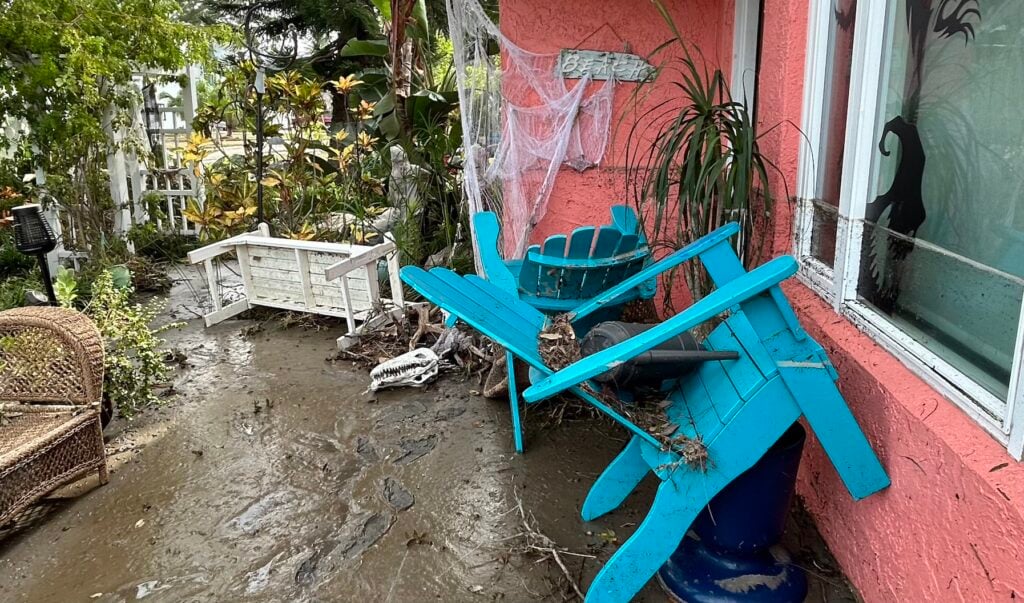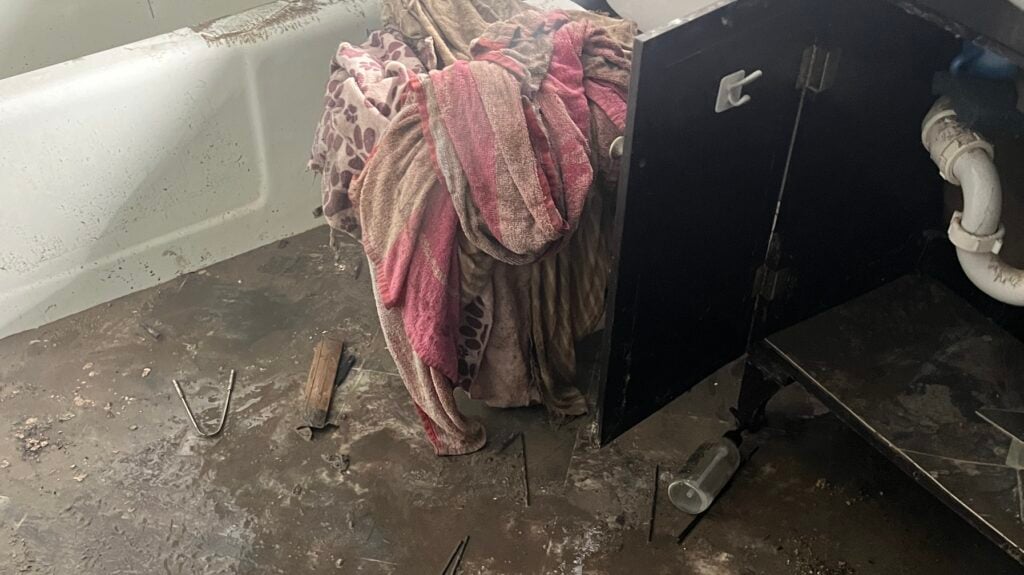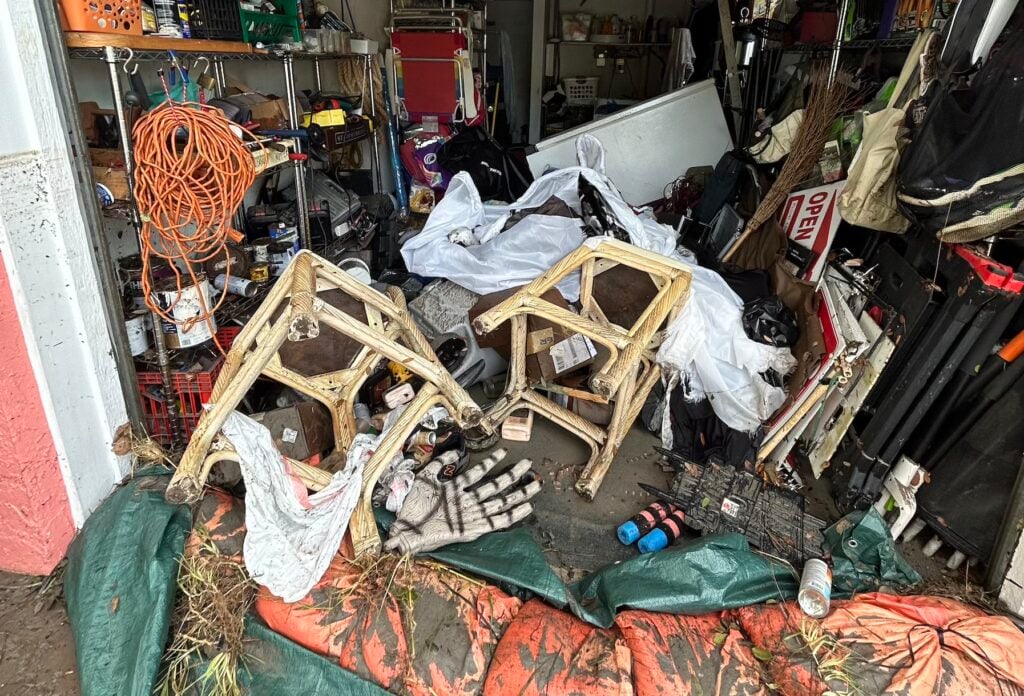My Story in the Storm: On the Ground After Helene and Milton
Published Oct 25, 2024
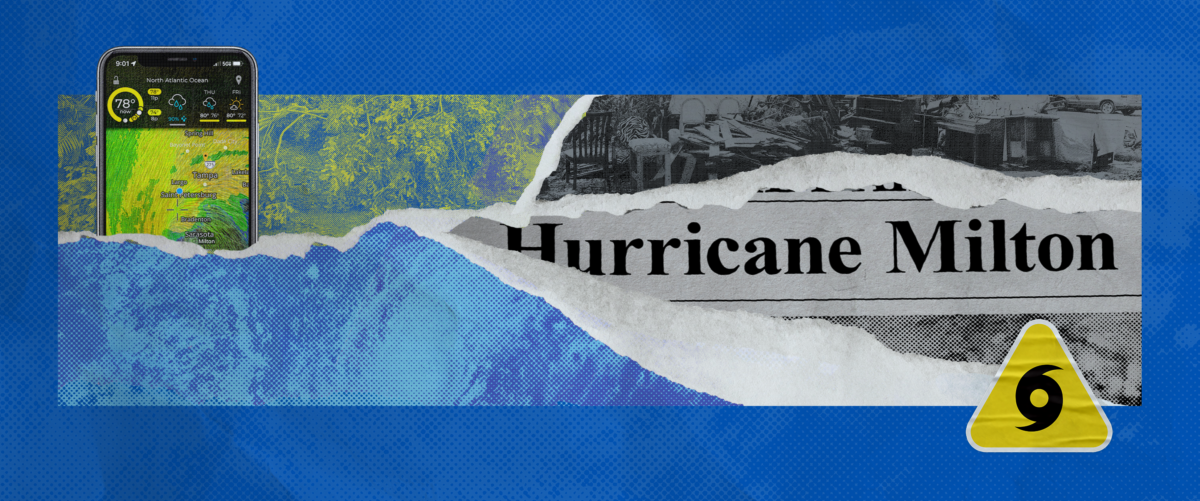
In the wake of two historic hurricanes, Brooke, FWW Senior Florida organizer, details the devastating impacts on her family and the need for climate action.
This fall, two major hurricanes ravaged Florida in just two weeks, leaving devastation in their pathway. Homes have been destroyed. Lives have been lost. Many of us are trying to figure out how to move forward at such a time of uncertainty.
Just over a month after Hurricane Debby flooded coastal properties, Hurricane Helene brought deadly storm surges and continued its path of destruction through six states in the Southeast. Tens of feet of water engulfed homes that weren’t even considered to be in the hurricane’s path.
While clean-up efforts were still in full swing, another monster hurricane headed directly into Florida’s Tampa Bay region. Hurricane Milton gave little notice and impacted most of peninsular Florida. President Joe Biden said that on October 12, more than 250,000 Floridians registered for help from the Federal Emergency Management Agency, “the most in a single day ever in the history of this country.”
As climate change worsens, these “once in a hundred years” and “once in a thousand years” storms are hitting us in rapid succession. In the past seven years, Florida has been hit by six of these “rare” storms, including Helene and Milton.
These storms bring with them other extreme weather events, like Milton’s record-breaking number of tornadoes. The burning of fossil fuels and the stalling of our renewable energy transition are driving the devastation to new heights.
I was born and raised in Florida. I celebrated my 44th birthday the week before Helene, and this fall was like nothing I’ve ever experienced before. Here’s my story from within the storms:
Thursday, September 26: Hurricane Helene
“Something about this storm was different.”
We had about a week’s notice that Hurricane Helene would land in the Big Bend of Florida, where the Panhandle curves into the peninsula. Big Bend was still recovering from last year’s Hurricane Idalia.
In the Tampa Bay region, we weren’t too concerned about the storm. We weren’t in the cone of uncertainty1The representation of the path and intensity of a hurricane., meaning we probably wouldn’t see much more than heavy rains and wind gusts near 90 mph. For Floridians, that’s giving your yard a good drink and having Mother Nature do some tree trimming for you.
But something about this storm was different. We’ve been hearing about this threat of storm surge for years now, but without much to show for it, except some flooded streets. They kept saying, though, that this was the storm they had been warning about.
I live about four miles inland in Pinellas County, in Flood Zone X; a no-flood zone. However, my parents live on a barrier island off the county’s west coast.
It’s a thin strip of land about one block wide, where I grew up playing on our sugar sand beaches and chasing lizards in the yard. In my parents’ 48 years there, they’d only had flooding once, in 1993, and that was only four inches. So, when the County issued its evacuation orders, my parents weren’t that concerned.
I was. Little did I know then how concerned I should have been.
“It happened quickly, so quickly.”
My parents reluctantly evacuated to my house after several entreating calls. Soon after they finally arrived, the first winds and rain of Helene came, too. We turned on the beach cams trained on the beaches and south side of the peninsula.
Some of Mom and Dad’s neighbors stayed. After all, that’s what real Floridians do. The thing about living on a peninsula is that there is only one way out, and the interstate becomes a parking lot prior to a storm. You don’t want to be sitting on the interstate when you could be chilling at home.
We watched the beach cam footage as evening came and the waters engulfed the sands.
It happened quickly, so quickly. Mom’s neighbor ominously texted, “Here it comes.” Twelve feet of storm surge hit from all angles. We later heard stories from folks who had been sitting on their couch having a cocktail and then minutes later were scrambling onto kitchen countertops to avoid the four, five feet of water filling their homes.
One elderly couple on the street where my parents live got scared that they were going to drown in their home — and some people did. They left their house in the middle of the surge, barely surviving after momentarily getting washed away.
My best friend called me from her fifth-floor condo in a panic. She FaceTimed me to show that giant waves were lapping over the building. SUVs were floating around, ramming each other in the parking lot, and in the distance, transformers were exploding, burning parts of the city. This was four hours before high tide when the storm surge would reach its peak.
Overcome with emotions, we eventually fell asleep until morning.
Friday, September 27: The Aftermath
“An inch of sewer sludge covered the entire street.”
The next morning, we started hearing reports of the damage. Roadways covered in sand, sludge, and debris. Boats and cars displaced, blocking streets and driveways. People drowned in their homes.
For two whole days, emergency crews conducted rescue missions and attempted to clear roadways, as the destruction left residents without basic or emergency services. On Saturday, residents were allowed to return with caution. Mom and I headed over.
I always thought that flood waters, although scary, were just water, so the aftermath would be clean. Boy, did I think wrong.
Storm surge is like the ocean’s vomit. Along with everything nasty the ocean has to offer, the waters mix with road filth and sewage from overfilled drainage infrastructure. When we arrived, an inch of sewer sludge covered the entire street.
Entering through the front door or garage was impossible. We headed to the backyard and climbed through my old bedroom window. On the way, we saw that the pool had become a swamp (one we weren’t yet ready to drain), and in true Florida style, one of Mom’s decorative alligators had taken up residence.
At the window, I popped out the screen and hoisted Mom inside. She let us in through the backdoor to find — chaos. Complete destruction. Not hyperbole. The surge destroyed everything under four feet.
We discovered that the laminate click planks of the downstairs floor had warped so that entering through the front door was going to take some demolition work.
In the kitchen, the refrigerator had traveled across the room and spilled its contents. Publix had had a sale on scallops the week prior, and Mom had loaded up. The slightly rotting seafood seemed all too apropos.
“There is no rest in remediation.”
We spent the next week doing remediation. We bonded with other survivors in the galoshes section of Walmart because they were the only thing that allowed movement through the sludge.
Mom and I emptied 48 years of life onto the street, nothing salvageable. We ripped out floors, cut out drywall, ran industrial fans and dehumidifiers. Bleach and OdorBan became our best friends. Day after day of emotional, hard labor was necessary to keep mold from overtaking the house completely.
There is no rest in remediation. Friends, family, and church volunteers pitched in. Every day was traumatic, working in sewer-like conditions.
And the smell, oh, the smell. We’d head home at the end of the day — my homeless parents were now living with us — and no matter how much scrubbing, that smell would stay with us, in our nostrils and our memories. And we were the lucky ones, having an unscathed home to return to at the end of the day.
Then, one week later, we heard from those in the real world that another storm was coming. It was bigger, badder, and would be here in three days.
Wednesday, October 9: Hurricane Milton
“This was the ‘once in a thousand years storm.'”
Hurricane Milton came out of nowhere. We didn’t have our typical week’s notice to prepare. It grew from a tropical storm to a Category 5 (the worst category) hurricane in under 24 hours. And it was headed. Straight. For. Us.
The Tampa Bay region went into a panic. People boarded up and left. Those of us still recovering from Helene were in a whirlwind. Mountains of debris still lined streets, threatening to become deadly projectiles in the storm. The counties went on 24/7 debris removal to mitigate potential damage. This was the “once in a thousand years” storm.
Let me tell you something about a Category 5 hurricane. It knows no limits. You can have the best hurricane shutters and a brand new roof, and a Cat-5 says “Thank you for trying” while it rips them off, leaving families huddled under mattresses fighting to survive.
We had four adults and four dogs — not an easy crew to evacuate. In fact, pets and finances are the main reasons people don’t leave. Not everyone has the luxury of evacuating.
None of our options — south to Fort Lauderdale, east to Tampa, north to Georgia along the I-75 “parking lot” — seemed like sure bets for safety.
The morning of October 7, (my parents’ 52nd wedding anniversary), Dad waited for four hours to get a generator in preparation for the inevitable power loss. My husband John and I waited in the longest line at Home Depot to get plywood.
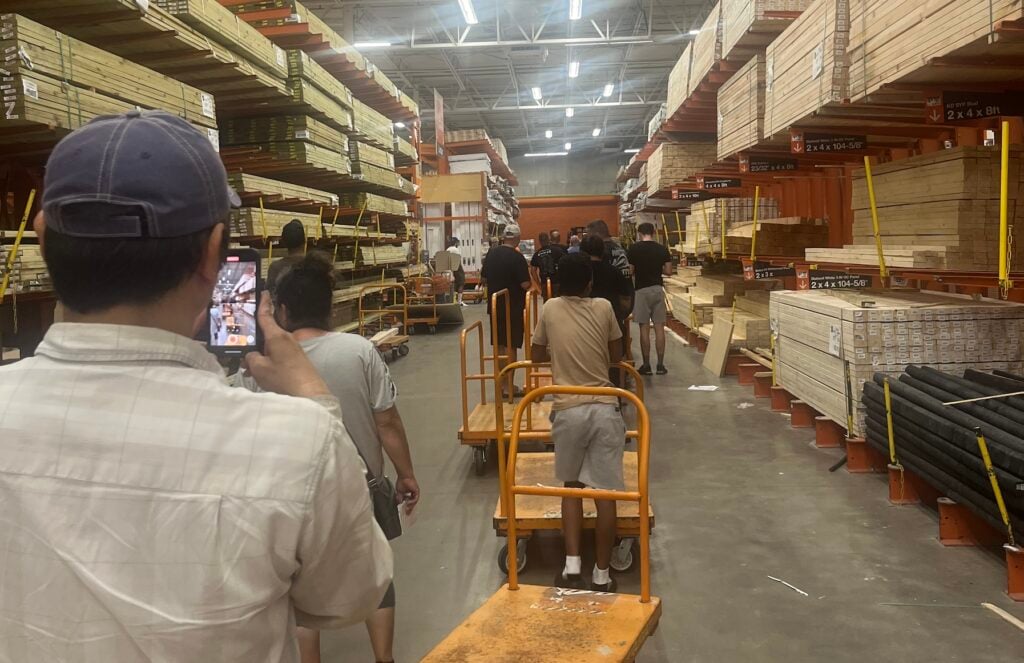
That evening, my parents decided to evacuate to Tampa. My father has been very ill for the past few months and was hesitant to make a long drive. Even after Milton downgraded to a Cat-3 Tuesday morning, Mom and Dad were heading out. There was still a chance it would return to a Cat-5. They did not want to re-experience the trauma after the last storm.
“This was the scariest storm I’ve ever experienced.”
John and I weren’t in a flood or evacuation zone. Boarded up and prepared with a generator, we decided that we would make our decision Wednesday morning based on the strength of the storm.
Hurricane Milton remained a Cat-3, and the projection of the eye shifted southward (there was a period where the eye was projected to go through our living room). We made the difficult decision to ride it out.
This was the scariest storm I’ve ever experienced. The 120 mph winds tried to suck out the back doors of our house. We heard large tree limbs smacking down on our roof and around our house.
The windows were boarded up, so we couldn’t see what was happening. We were relying solely on our hearing. The downpour brought 18 inches of rain in an hour, saturating the ground and seeping up from our floors through the concrete. Our dining room began to flood from standing water.
For six hours, Hurricane Milton thrashed our region before passing on. John and I slept in shifts to keep storm watch and act if needed. Then morning came.
“Our threshold for disaster had risen substantially.”
We all awoke to the destruction that Milton left in its path. Trees, fencing, and power lines down everywhere. One giant limb had knocked over our shed, blocking the back doors of the house. We went into remediation mode, clearing pathways, getting the generator going, and drying out our house.
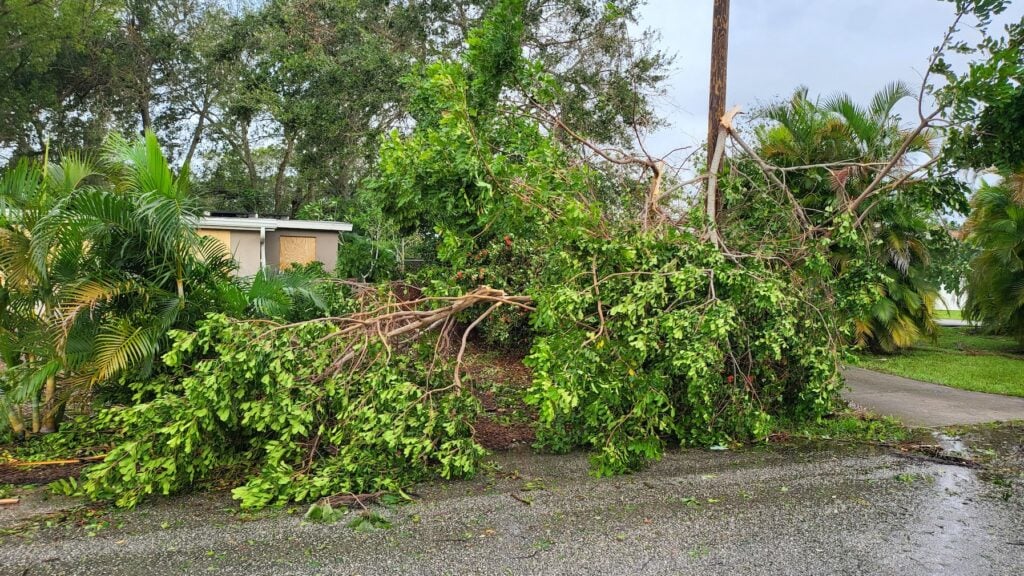
We had all the tools we needed because we’d just been through this at my parents’ house with Helene. The storm was destructive and scary, but our threshold for disaster had risen substantially.
For the next week, there were widespread power outages. It was the wild west of driving without traffic signals. (By the way, a non-working traffic light is a 4-way stop.)
Most grocery stores and restaurants were closed, having lost all of their food. Gas was non-existent, as Port Tampa Bay is the port where Florida’s gasoline is delivered. We joked with others in the community about selling “I survived a Cat-3” t-shirts. Because we did survive.
Climate Action Now. No Excuses.
These storms have become the new “normal” in Florida. But despite being hit with back-to-back disasters, Governor Ron DeSantis denies these storms’ link to climate change.
Earlier this year, he signed into law an omnibus bill removing climate change from consideration in state planning and resiliency efforts. What’s more, people still buy into the conspiracy that the government is using a giant weather control gun to send hurricanes to Florida, rather than the scientifically proven connection to human-caused climate change.
Florida is ground zero for climate chaos. This hurricane season made it clearer than ever that we need bold climate action now to phase out fossil fuels and make historic investments in resiliency infrastructure. Florida elected officials (from city to federal) must prioritize policies that prevent and protect against catastrophic weather events.
The time to act is now. We are all tired, but Floridians are also fighters. We are resilient, and together we can fight to protect this paradise we call home.
Tell Florida leaders: End fossil fuels, take climate action now!
Enjoyed this article?
Sign up for updates.
TO TOP
Endnotes



